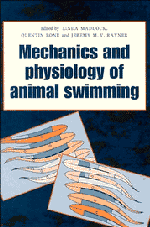Book contents
- Frontmatter
- Contents
- Contributors
- Introduction
- 1 Functional patterns of swimming bacteria
- 2 Buoyancy and swimming in marine planktonic protists
- 3 The role of fins in the competition between squid and fish
- 4 The biology of fish swimming
- 5 Swimming physiology of pelagic fishes
- 6 The mechanical design of the fish muscular system
- 7 How do fish use their myotomal muscle to swim? In vitro simulations of in vivo activity patterns
- 8 The timing of lateral muscle strain and EMG activity in different species of steadily swimming fish
- 9 Swimming in the lamprey: modelling the neural pattern generation, the body dynamics and the fluid mechanics
- 10 Swimming capabilities of Mesozoic marine reptiles: a review
- 11 Stone, bone or blubber? Buoyancy control strategies in aquatic tetrapods
- 12 Functional anatomy of the ‘flight’ apparatus in penguins
- 13 Energy conservation by formation swimming: metabolic evidence from ducklings
- Bibliography
- Index
9 - Swimming in the lamprey: modelling the neural pattern generation, the body dynamics and the fluid mechanics
Published online by Cambridge University Press: 05 March 2012
- Frontmatter
- Contents
- Contributors
- Introduction
- 1 Functional patterns of swimming bacteria
- 2 Buoyancy and swimming in marine planktonic protists
- 3 The role of fins in the competition between squid and fish
- 4 The biology of fish swimming
- 5 Swimming physiology of pelagic fishes
- 6 The mechanical design of the fish muscular system
- 7 How do fish use their myotomal muscle to swim? In vitro simulations of in vivo activity patterns
- 8 The timing of lateral muscle strain and EMG activity in different species of steadily swimming fish
- 9 Swimming in the lamprey: modelling the neural pattern generation, the body dynamics and the fluid mechanics
- 10 Swimming capabilities of Mesozoic marine reptiles: a review
- 11 Stone, bone or blubber? Buoyancy control strategies in aquatic tetrapods
- 12 Functional anatomy of the ‘flight’ apparatus in penguins
- 13 Energy conservation by formation swimming: metabolic evidence from ducklings
- Bibliography
- Index
Summary
This paper investigates the overall problem of lamprey locomotion. A simple connectionist network is used to model the central pattern generator found within the lamprey spinal cord. The formation of the wave of body curvature produced by neural activity is modelled in terms of a mechanical structure composed of elementary components. A new approach to the problem of aquatic propulsion is proposed in which the standard equations of hydrodynamics are solved numerically for a given motion of the body.
INTRODUCTION
The lamprey is an anguilliform swimmer: thrust is developed by the rostral-caudal passage of a wave of curvature over most of the body length. The patterns of muscle activity giving rise to this curvature are generated by pattern-generating circuitry within the spinal cord and continuously modified by sensory feedback (see Figure 1). Movement arises from the interactions of neural activity, the biochemical and physical properties of muscle, and the mechanical properties of both the body and the water. In this chapter we briefly discuss three aspects of this complex system. A brief review of work on pattern generation by the lamprey spinal cord will be followed by a presentation of a mechanical model of the lamprey body, and its interactions with muscle activation. Finally, the results of some initial studies of the hydrodynamics of anguilliform swimming will be given, along with an outline of future work to be carried out.
CENTRAL GENERATION OF THE LOCOMOTOR PATTERN
The pattern of muscle activation during swimming consists of alternating bursts of activity in the left and right ventral roots of each segment, with a rostral-caudal delay of activation along the length of the spinal cord (Figure 1).
Information
- Type
- Chapter
- Information
- The Mechanics and Physiology of Animal Swimming , pp. 119 - 132Publisher: Cambridge University PressPrint publication year: 1994
Accessibility standard: Unknown
Why this information is here
This section outlines the accessibility features of this content - including support for screen readers, full keyboard navigation and high-contrast display options. This may not be relevant for you.Accessibility Information
- 10
- Cited by
